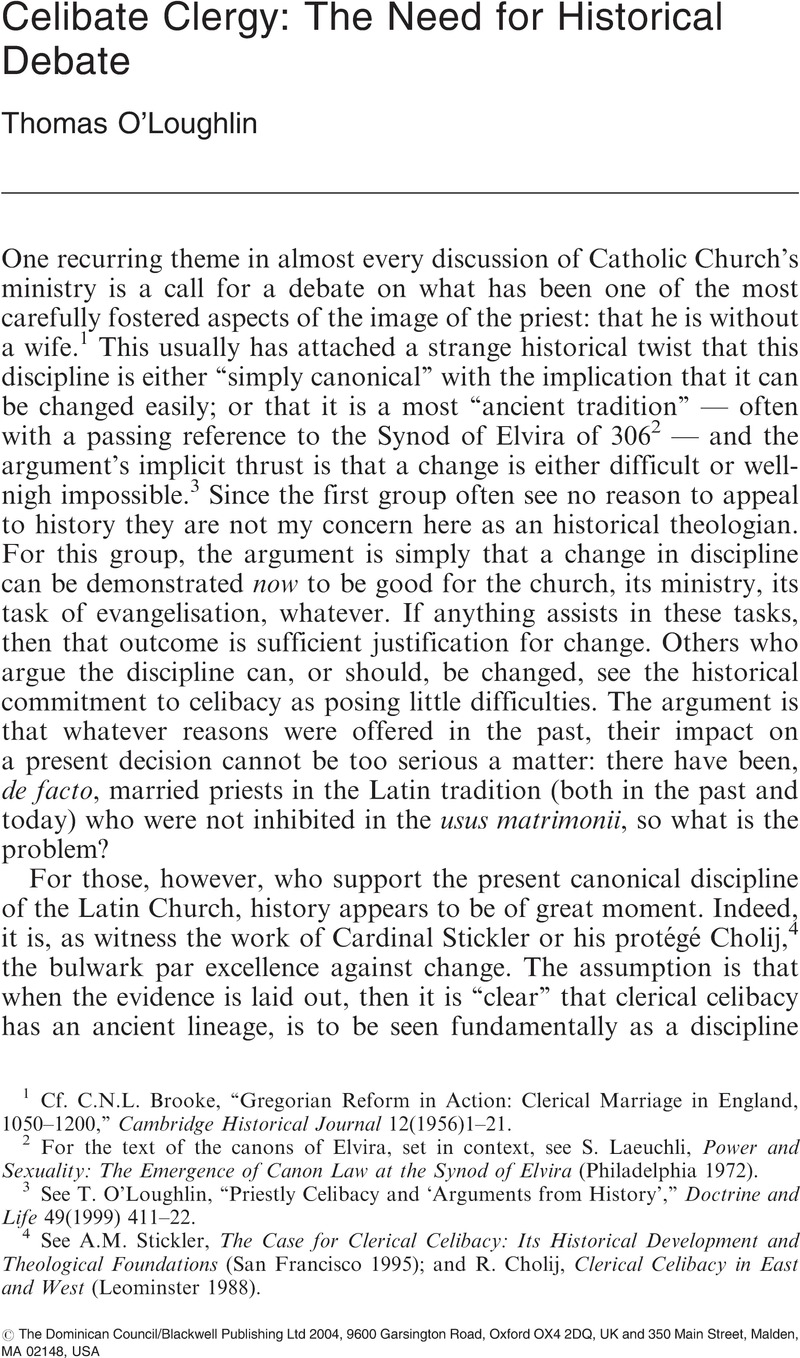Published online by Cambridge University Press: 01 January 2024

1 Cf. Brooke, C.N.L., “Gregorian Reform in Action: Clerical Marriage in England, 1050–1200,”Cambridge Historical Journal 12(1956)1–21CrossRefGoogle Scholar.
2 For the text of the canons of Elvira, set in context, see Laeuchli, S., Power and Sexuality: The Emergence of Canon Law at the Synod of Elvira(Philadelphia 1972)Google Scholar.
3 See O’Loughlin, T., “Priestly Celibacy and ‘Arguments from History’,”Doctrine and Life 49(1999) 411–22Google Scholar.
4 See Stickler, A.M., The Case for Clerical Celibacy: Its Historical Development and Theological Foundations(San Francisco 1995)Google Scholar; and Cholij, R., Clerical Celibacy in East and West(Leominster 1988)Google Scholar.
5 Once anything is codified in law, it is automatically related to precedents and so becomes part of the “seamless robe” of law — in all such cases to then argue that the law is a legitimate “development” is virtually to argue in a circle.
6 Tablet, editorial, 4 May 2002.
7 Commonitorium 2,5 (CCSL 64, p. 149); cf. O’Loughlin, T., “Newman, Vincent of Lerins and Development,”Irish Theological Quarterly 58(1991)147–166CrossRefGoogle Scholar.
8 Early Christian historians did not write “church history” in the sense of a specific branch of the discipline dealing with one aspect of society (e.g. as “military history” deals with soldiers; so “church history” deals with believers’ societies); rather they saw it as the history of communities of Christians acting as churches.
9 Cf. Contreni, J.J., “‘lions, bishops are meant; by wolves, priests’: History, Exegesis, and the Carolingian Church in Haimo of Auxerre's Commentary on Ezechiel,”Francia 29/1(2002)29–56Google Scholar which not only deals with this sense of today being the whole age after Christ, but also deals with the systematic relegation of marriage to an inferior spiritual state, and hence one that is not truly suitable for those who are pastors.
10 See Kuttner, S.G., Harmony from Dissonance: An Interpretation of Medieval Canon Law(Latrobe 1960)Google Scholar, passim.
11 Cf. O’Loughlin, T., “Medieval Church History: Beyond apologetics, after development, the awkward memories,”The Way 38(1998)65–76Google Scholar; and idem, “Theologians and their use of historical evidence: some common pitfalls,”The Month 261(2001)30–35Google Scholar
12 In the 1922 edition of H. Denzinger's Enchiridion symbolorum(ed. 14 by C. Bannwart and J.B. Umberg; Freiburg) the first appendix (p. 1*) was entitled De coelibatu clericorum and (surprisingly in a work dedicated to papal degrees and councils judged to be “ecumenical”) supplied the relevant canons from the local synod of Elvira.
13 On the changes in history writing, see Frend, W.H.C., From Dogma to History: How Our Understanding of the Early Church Developed(London 2003)Google Scholar.
14 The English translation of the three volumes appeared in London, 1901–1922; for an appreciation of this monument of early critical scholarship in history by a Roman Catholic, see Frend, op. cit., pp. 108–143.
15 However, such a relationship of dependency can even be seen in those who pioneered the modern discipline of church history such as Duchesne.
16 See Taft, R., “The Structural Analysis of Liturgical units: An Essay in Methodology,”Worship 52(1979)314–329 at 317–8Google Scholar.
17 See O’Loughlin, T., Teachers and Code-Breakers: The Latin Genesis Tradition, 430–800(Turnhout 1999), pp. 39–72CrossRefGoogle Scholar.
18 Such were the first collections of canon law.
19 It should be noted that there is still no detailed modern history of celibacy, hence one must still look at Lea, H.C., History of Sacerdotal Celibacy in the Christian Church(2 vols, London 1907)Google Scholar which is hostile in tone and argument, uncritical in the way it uses many sources, and dated in its theological assumptions.
20 See Hoge, D.R., The Future of Catholic Leadership: Responses to the Priest Shortage(Kansas 1987)Google Scholar.
21 See Brooke, C., The Medieval Idea of Marriage(Oxford 1989)Google Scholar, ch. 3: “The Cult of Celibacy.”